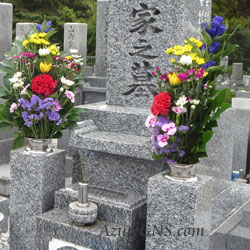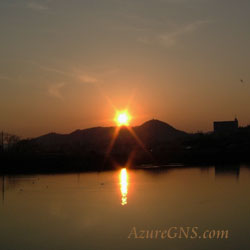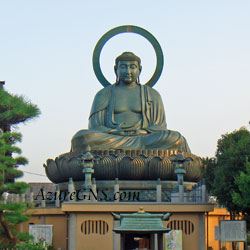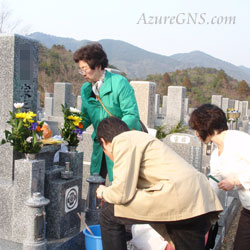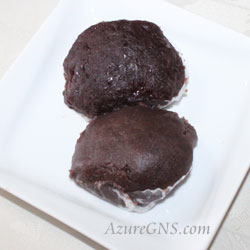国民の祝日
(3月22日頃)
National Holiday
Shumbun-no-hi;
Vernal Equinox Day
(on or around March 22nd)
●春分の日 Shumbun-no-hi; Vernal Equinox Day
●秋分の日 Shubun-no-hi; Autumn Equinox Day
●夏至 the summer solstice
●冬至 the winter solstice
●彼岸 the equinoctial week
●赤道 the equator
●煩悩 worldly desires; earthly desires; worldly passions; earthly passions
●先祖;祖先 ancestor; (主に男性)forefather; (集合的に)ancestry
●子孫 descendant; (集合的に)posterity
●墓 grave; tomb
●墓地 graveyard; (教会に属さない共同墓地)cemetery; (教会付属)churchyard;(婉曲的に)memorial park
●墓参りをする (to) visit one’s grave
◆昼と夜の長さがほぼ同じ長さになる日が年2回あります。
There are two days in the year when the length of daylight and night are almost equal.
◆春のその日を春分の日、秋のその日を秋分の日といいます。
One is in spring called Shumbun-no-hi (Vernal Equinox Day), and the other is in autumn which is called Shubun-no-hi (Autumn Equinox Day).
◆これらの日、太陽は赤道の上を横切り、太陽は真東から昇り、真西に沈みます。
On these days, the sun is positioned directly over the equator and rises in the east and sets in the west.
◆春分の日は3月22日頃、秋分の日は9月22日頃です。
Shumbun-no-hi is on or around March 22nd, and Shubun-no-hi is on or around September 22nd.
◆春分の日を境に夏至まで昼が徐々に長く、夜が徐々に短くなります。
From Shumbun-no-hi to the summer solstice, the days gradually become longer while the nights become shorter.
◆秋分の日を境に冬至まで昼が徐々に短く、夜が徐々に長くなります。
From Shubun-no-hi to the winter solstice, the days gradually become shorter while the nights become longer.
◆春分の日と秋分の日の前後合わせて7日間をどちらも彼岸といいます。
The 7 days centering around each equinox are special days known as Higan.
◆最初の3日を彼岸の入り、4日目の春分の日と秋分の日を彼岸の中日、最後の3日を彼岸の明けと呼びます。
We call the first three days Higan-no-iri, the fourth day (Shumbun-no-hi or Shubun-no-hi) Higan-no-chunichi and the last three days Higan-no-ake.
◆彼岸は本来、煩悩の無い、悟りをひらいた世界のことです。
Originally, Higan was the Buddhist world where no one had any earthly desires, and everyone attained spiritual enlightenment.
◆そして後に亡くなった祖先たちが住む世界を意味するようになりました。
Higan later came to mean the world where deceased ancestors live.
◆彼岸の7日間はお盆の時期と並んで仏教では大切です。
The 7 days of Higan, as well as the season of O-bon are important in Buddhism.
◆このような時、家族で一緒に祖先のお墓参りをします。
On these occasions, families get together to visit the graves of their ancestors.
◆お墓を丁寧に掃除して、線香、花、水、果物、菓子などを供えて、お参りします。
People thoroughly clean the graves, light incense and offer flowers, water, fruits, sweets and so on and pray.
◆彼岸にはもち米のおむすびを餡で包んだ和菓子を食べます。
During Higan, people eat Japanese sweets that are glutinous rice-balls covered with anko (sweetened bean-paste).
◆この和菓子を春の彼岸の時は春に咲く牡丹の花にちなんでぼたもちと呼ばれています。
During Higan in spring, these Japanese sweets are called bota-mochi after botan (a peony), which blooms in spring.
◆秋の彼岸の時は秋に咲く萩の花にちなんでおはぎと呼ばれています。
During Higan in autumn, these Japanese sweets are called ohagi after hagi (a bush clover), which blooms in autumn.
◆花の大きさを考えて、ぼたもちはおはぎより大きめに作ります。
With regard to the size of the flowers, bota-mochi is a slightly bigger than ohagi.
(より詳しい情報は「秋分の日」と「お盆」をご覧下さい。)
(Please see “Autumn Equinox Day” and “The Buddhist Souls Festival” for further information.)
Copyright (C) Azure Global Network Services. All Rights Reserved.

